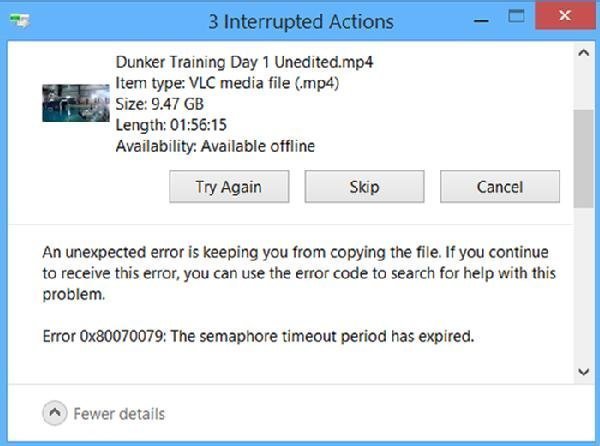


- Windows server file copy log code#
- Windows server file copy log free#
- Windows server file copy log windows#
For information about Windows Event Collector, see the Microsoft documentation. Select the type of logs you need to export: usually, Application and System logs are required. For information about Log Insight, go to. The target log file has the latest detail in it copied from the source log. To view the event log from a centralized location, configure VMware Log Insight or Windows Event Collector. You may need to either write a PowerShell script to read the network file starting from the end of the old file, or use a Linux/WSL program tail -c + previous size to start at a specific byte offset of the file. To view the event log in the agent machine, use the Windows event viewer. The event log where information about copy and paste activity is recorded is named VMware Horizon RX Audit. You can optionally configure the Whether block clipboard redirection to client side when client doesn't support audit group policy setting to specify whether to block clipboard redirection to clients that do not support the clipboard audit feature.įor more information about the group policy settings for clipboard redirection, see the Horizon Remote Desktop Features and GPOs document. You can configure the clipboard audit feature to record information only about data that is copied from the client machine to the agent machine, only about data that is copied from the agent machine to the client machine, or about data that are copied in both directions. To activate the clipboard audit feature, you must configure the Configure clipboard audit group policy setting. It does not apply to copying and pasting files and folders. This feature applies only to copying and pasting text and images. The clipboard audit feature is deactivated by default. In the PING command above, 10 phantom PINGS are executed with a delay of 6000ms (ie: 6 seconds) between them, you can play with these values to achieve the delay you need between batch file loops.When an administrator activates the clipboard audit feature, Horizon Agent records information about copy and paste activity in an event log in the agent machine. There are other ways of achieving a delay according to the version of Windows running and what additional resource kits have been installed, but the PING command pretty much works under all circumstances.

IF NOT EXIST C:\SOMEWHERE\SUBFOLDER\THISFILE.THS GOTO SKIP01
Windows server file copy log code#
You could also modify this code and have it run in a loop with a, say, 1 minute delay in the loop and then put a reference to the batch file in the Windows startup folder: OFF REM All this gets done if the file exists. IF NOT EXIST C:\SOMEWHERE\SUBFOLDER\THISFILE.THS EXIT 1 cmd file on a regular basis and that file could start with a line to check for the existence of the required file - in fact, I'd check for the non existence of the file for example: OFF You seem to be on the right lines - you could use the task scheduler to run a. File Server Resource Manager (FSRM) is a role service in Windows Server that enables you to manage and classify data stored on file servers. (Also, I don't want to leave this question officially unanswered - and I hate to accept my own answer to the question - but I did upvote Linker3000's answer as a thanks!) But it was asked frequently by our customers. Applies to: Windows Server 2022, Windows Server 2019, Windows Server 2016, Windows Server 2012 R2, Windows Server 2012, Windows Server 2008 R2. StrTempFilePath = WScript.CreateObject("Scripting.FileSystemObject").GetSpecialFolder(2) & "\TEMP.M4A" StrFileName = Replace(strFilePath, strFolder, "") StrFilePath = Replace(strFilePath, Chr(34), "") StrFilePath = Replace(strFilePath, "\\", "\") However it may not help a lot on tracking users from copying a large mount of data, as you will receive a lot of logs when users copy the files and it is a little difficult to judge its 'large amount' or not. Set objLatestEvent = colMonitoredEvents.NextEvent Hi Dom, Audit could help on monitoring files copy. Set colMonitoredEvents = objWMIService.ExecNotificationQuery ("SELECT * FROM _InstanceCreationEvent WITHIN " & nFrequency & " WHERE Targetinstance ISA 'CIM_Director圜ontainsFile' and TargetInstance.GroupComponent='Win32_Directory.Name=""" & strQueryFolder & """'") and create a start menu icon, a desktop icon etc.
Windows server file copy log free#
$action = !\\" & strComputer & "\root\cimv2") WinSCP Files WinSCP is a free SFTP, SCP, S3, WebDAV, and FTP client for Windows. # DEFINE ACTIONS AFTER AN EVENT IS DETECTED $watcher = New-Object System.IO.FileSystemWatcher StartMonitoring.ps1 # SET FOLDER TO WATCH + FILES TO WATCH + SUBFOLDERS YES/NO 19:22:14, Deleted, D:\source\New Text Document.txt 19:22:09, Changed, D:\source\New Text Document.txt 19:22:04, Created, D:\source\New Text Document.txt You can replace the action and do whatever you want e.g call an external tool Example log file This script monitors a certain folder and writes a logfile. It can be used since Windows Vista (.NET and PowerShell is preinstalled) without any additional tools. At work we use Powershell to monitor folders.


 0 kommentar(er)
0 kommentar(er)
